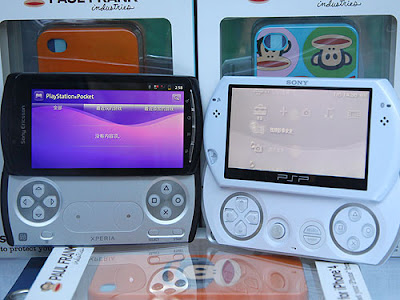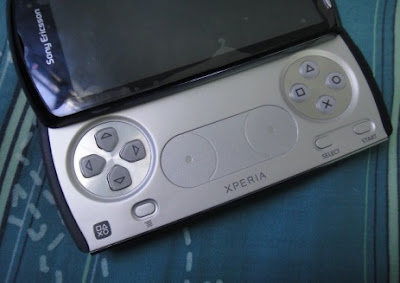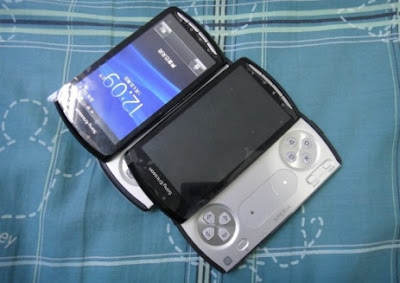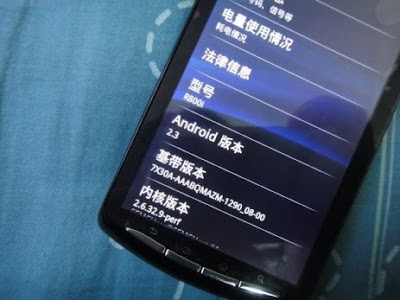
Looking at the baseline internal specs for a moment, the PSP Phone is powered by a Snapdragon QSD8255 system-on-a-chip (SoC), which contains both the main processor and the system graphics chip. Onboard the SoC we have a Qualcomm Scorpian CPU, based on ARMv7 tech, which is running at 1GHz, and a Adreno 205 GPU, both of which can also be found powering the Samsung HTC Desire HD.
In addition to the SoC responsible for processing data on the device, we also see that the PSP Phone has 512MB of RAM. Currently, it isn’t clear if this is the total amount of memory available to the device, or if a separate pool of VRAM is available exclusively for the Adreno 205 GPU. In any case, 512MB is far more than the 64MB present in the PSP Go, and should be enough to suffice.
In terms of overall performance, that overall configuration puts Sony’s device almost on par with the iPhone 4, and almost certainly at the high-end of the spectrum when it comes to smartphone technology, but behind the rumoured specs of the PSP2. Surprisngly the system appears to be far more powerful than what previous sources led us to believe.
Here we have graphics hardware that supports OpenGL 2.0, along with shader model 4, which puts it firmly above that of the 3DS, and allowing it to handle similar visuals to that of Infinity Blade running on an iPhone 4 – that is to say, capable of producing 1st gen 360-esque graphics.

The familiar architecture, and use of the Android 2.3 OS, should also allow the device to play current games powered by the Android platform, along with titles designed purely around the system’s specific hardware, running only on the PSP Phone. Unlike with games tailored to run in the confines of the Android OS and its API’s – which have to maintain compatibility with a range of different devices – PSP Phone specific titles could be developed to take full advantage of the hardware, delivering better visuals and higher levels of performance.
That said, some of the best looking Android compatible titles already look stunning - A version of the Epic Citadel demo, running on Android plus NVIDIA Tegra hardware, and Infinity Blade on the iPhone 4, are both a good indication of what software is expected to look like on the platform.
Compared to the 3DS, custom, fully programmable pixel shaders allow for a more precise, diverse range of effects, along with fully customisable lighting and shading routines over and above what fixed-function hardware can do – the 3DS supports only programmable vertex shaders – no pixel shaders - and fixed-function, per-pixel lighting. However, its per-pixel, fixed-function set-up can yield similar, if less accurate, results compared to programmable shader hardware.
Moving on, and the device also features a a 4” 854x480 resolution LCD display, which compares favourably to the iPhone 4’s 960x640 Retina screen, and provides around double the vertical and horizontal resolution of the PSP Go’s a 3.8-inch 480 x 272 display. You’ll also find a 5 megapixel autofocus camera complete with LED flash, and a range of slots including a microSD slot, SIM slot, and a micro-USB input.

Software-wise, the PSP Phone will be using something described as the ‘PlayStation Pocket’, which sounds very similar to earlier leaked info surrounding a network hub for downloading PS specific games – either PSone titles or ported PSP games and PSP Phone exclusives.
At present, it’s not yet known what games will be heading onto the device - speculation hints at PSone and PSP games, although PSP games would have to be ported, seeing as full-speed emulation isn’t really possible on the hardware. PSone on the other hand, would be easy to do. The obvious downside would be that most titles are rendered in 240p vertical resolution, with only a few using a 480p framebuffer, which would mean they would have to be upscaled to fit the PSP Phone’s screen. However, as we’ve seen on the PS3, this doesn’t always result in poor image quality.
But how does this ‘PlayStation Pocket’ fit into things in general? Over the last few months we’ve heard reports stating that a new Google ecosystem will be largely powering software and content distribution across the device, in-line with other new Sony Ericsson products. However, Sony themselves have also stated their intention in branching out the PlayStation Network brand across to other devices, such as MP3 players, TV’s, and smartphones.
While the PSP Phone seems to the perfect container in order to finally unify the brand across platforms, different strategies between SCE and Sony Ericsson may well prevent this from going ahead quite so soon. Both divisions are looking to trial and expand different concepts into the market. At present, it very much looks like the PSP Phone may well be a compromise of sorts – using a separate PlayStation branded area for games alongside the main Google ecosystem delivering content to the device.

All in all, the PSP Phone is certainly an interesting piece of kit. It is considerably more powerful than previous leaks had suggested, almost matching the iPhone 4 in terms of raw performance – going by the specs of the main SoC and RAM configuration – and has all the features of a regular multimedia smartphone.
It is then, perhaps a little surprising to see Sony pushing for two separate devices: a largely PS-less branded PSP Experia phone, and a bleeding edge, high-end PSP2. Considering the power of the PSP Phone, it would make far more sense to sell a device that both plays games, while also doubles up as a phone. Why not simply keep the phone integration, but for gamers who don’t want it, exclude the sim card package needed for its use. This makes far more sense than having two differering PS handheld products on the market, each further splitting it further.
Apple has shown that convergence between multiple devices – especially higher-end – is by far the way to go. Some analysts have already described the PSP2 as ‘dead on arrival’ admittedly along with the PSP Phone. However, Sony could use this Xperia/PS branded device as a natural successor to the PSP (ditching the PSP2), whilst also reaching out to the mainstream iPhone 4 consumer in general, thus avoiding all the pitfalls of having an expensive ‘gaming centric’ device that doesn’t completely rival its more mainstream competitors.
How the PSP Phone will fare is anyone’s guess, especially in a crowded market in which even Sony’s plans for full support are in question/unknown. With the PSP2 all but confirmed, and certainly in the pipeline, Sony’s gaming/cellular crossover may well not be quite the iPhone rival some of us hoped it would be. That said, it will be interesting to see just how the company positions this device alongside the PSP2, and in direct competition to Apple’s leading smartphone.

is PSP Phone for real????
ReplyDeletei hope this is real.... and i think this will beat the popularity of iPhone and tablet PC once it's release....
Free Torrents Download
I cant wait till i can get my hands on this phone i hope it can acctually play ps one games like the ones downloaded from psn
ReplyDeleteEpic Citadel is in no way first gen XBox 360 esque graphics though, well apart from texture resolution. For all the shader model 4 support of these devices the likes of Epic Citadel look like suped up last gen titles. Where's the per pixel lighting?, self shadowing?, even decent dynamic shadows? Isn't it odd that these devices have the pixel shaders that put them ahead of 3DS yet its 3DS that's showing games with 360 style effects? I suspect the reason for that is that while these GPU's are flexible, they aren't powerful enough to use that flexibility.
ReplyDelete